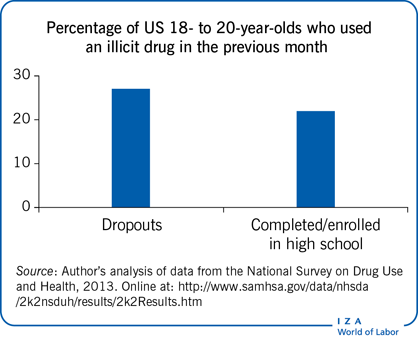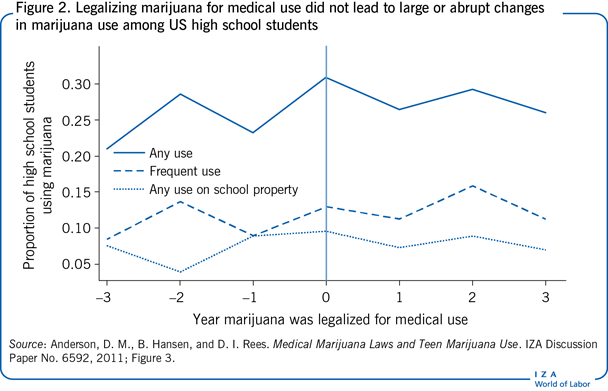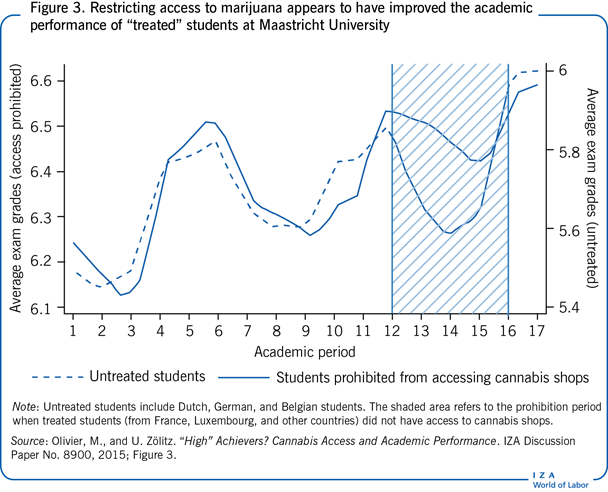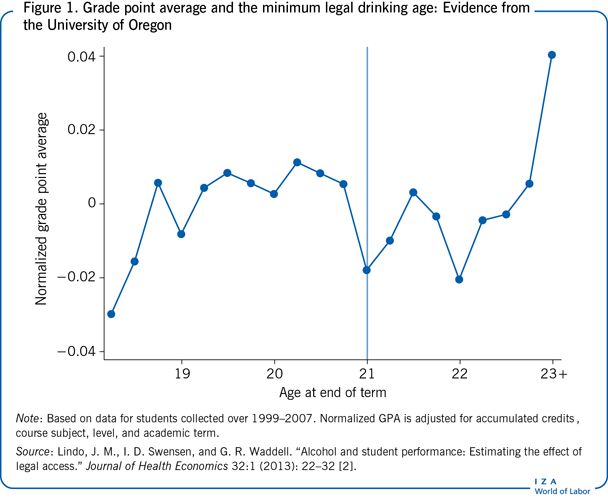Elevator pitch
A non-trivial portion of traffic fatalities involve alcohol or illicit drugs. But does substance use—which is linked to depression, suicide, and criminal activity—also reduce academic performance? Recent studies suggest that the consumption of alcohol has a negative effect on the grades of university students. Likewise, there is evidence that marijuana use reduces the academic performance of university students. Although students who use illicit substances are more likely to drop out of high school than those who do not, this may reflect the influence of other, difficult-to-measure factors at the individual level, such as personality.

Key findings
Pros
Several studies provide convincing evidence that alcohol consumption reduces academic performance as measured by grades of university students.
There is reasonably strong evidence that the use of marijuana reduces the academic performance of university students.
Cons
Alcohol use does not seem to appreciably reduce the probability of attending, or graduating from, university; but more research is needed on this topic.
There is evidence, albeit weak, that drinking reduces the probability of graduating from high school.
Illicit drug use by teenagers appears to be unresponsive to policy intervention, and, as a consequence, very little is known about its relationship to important educational outcomes such as dropping out of high school.
Author's main message
To date, researchers have not produced credible evidence that alcohol use affects educational attainment as measured by, for instance, years of education or the likelihood of dropping out of high school. By contrast, the consumption of alcohol appears to negatively impact the grades of university students. Likewise, there is evidence that marijuana use reduces the academic performance of university students. The use of other illicit drugs is correlated with poor educational outcomes, but no causal relationship has been demonstrated as of yet. Illicit drug use by teenagers is generally unresponsive to policy, so credible natural experiments are rare. Without them, the effects of substance use cannot be distinguished from those of personal characteristics.
Motivation
There are several reasons why substance use might affect outcomes such as grades, the probability of graduating high school, and the probability of continuing on to university. For instance, substance use could divert time and energy away from studying. It is also possible that substance use is causally related to these outcomes through its effects on cognitive functioning, attention span, short-term memory, or even self-esteem.
Of the many empirical studies on this topic, only a few provide credible estimates of the causal effects of substance use. Illicit drug use by teenagers appears to be largely unresponsive to policy, making convincing natural experiments rare. The minimum legal drinking age appears to generate substantial changes in alcohol consumption, providing researchers with a method for obtaining credible estimates.
Discussion of pros and cons
Numerous studies document a negative association between substance use and educational outcomes. This association is worrisome because society benefits when its members are informed and educated. But is it causal, or can it be ascribed to difficult-to-measure factors at the individual level, such as personality, family background, and how much an individual discounts future outcomes?
The cleanest, surest method of establishing causality would be to conduct a randomized controlled experiment. For instance, imagine randomly assigning students to treatment and control groups, ensuring that neither group has a disproportionate share of impulsive risk-takers. The treatment group would agree to use marijuana (or some other substance) as directed, while the control group would have no choice but to abstain. After some period of time, the effects of marijuana use on educational attainment (e.g. graduation from high school or the likelihood of attending university) and academic performance (e.g. test scores or grades) could be ascertained by simply comparing the two groups.
Because the experiment described above might raise eyebrows, researchers have increasingly turned to the next best thing: natural experiments. A natural experiment exploits an isolated change in conditions or incentives facing a subpopulation (often due to implementation of a government policy), but leaves an otherwise comparable subpopulation essentially untouched. If such a change is sufficiently abrupt—and sufficiently large—then it can be used in making causal inferences.
Only a handful of studies have attempted to use a clearly defined natural experiment to estimate the effect of substance use on student outcomes such as grades and the probability of graduating from high school. Some researchers have attempted to produce what they describe as causal estimates by exploiting cross-sectional policy variation or making sure that the substance use took place prior to the particular outcome under study. However, without a clearly defined natural experiment, it can be challenging to distinguish the effects of substance use from those of personality or family background.
Government policies and alcohol use
As noted, natural experiments are often based on a policy that changes the incentives facing a subpopulation. An obvious example would be a state excise tax on alcoholic beverages. A number of studies using data from the US have examined the relationship between beer taxes and youth drinking. Their results have been decidedly mixed.
By contrast, the evidence for the relationship between the minimum legal drinking age and alcohol consumption is much stronger. A number of studies find that increasing the minimum legal drinking age from 18 to 21 discourages drinking. In addition, there is evidence that alcohol consumption increases sharply at the minimum legal drinking age.
Alcohol use and academic performance
The sharp increase in alcohol consumption at the minimum legal drinking age has been exploited by researchers who are interested in the determinants of academic performance as measured by grades. For instance, a 2011 study based on data from the US Air Force Academy finds that gaining legal access to alcohol at age 21, the minimum legal drinking age, leads to a reduction in test scores of one-tenth of a standard deviation [1]. Although this reduction was precisely estimated, it may not reflect what happens when the typical university student gains legal access to alcohol. The Air Force Academy is extremely selective, most of its students are male, and most go on to become commissioned officers in the US Air Force. Furthermore, underage drinking is strictly prohibited at the Academy, a policy that could discourage high school students who are disposed to drinking from applying.
Another study based on data from the University of Oregon uses a similar empirical strategy to estimate the relationship between alcohol consumption and academic performance [2]. Students at the University of Oregon can be thought of as representative of students at public four-year institutions in the US. In the study, academic performance fell when students turned 21 before the end of an academic term (Figure 1). Specifically, turning 21 is associated with a 0.03 decrease in grade point average (GPA)—relative to a mean GPA of 3.11 among students in the sample. Moreover, using data on US students from the 1997 National Longitudinal Survey of Youth, the study finds that turning 21 is associated with a substantial increase in alcohol consumption. Specifically, the mean number of days per month on which alcohol is consumed increased from 4.3 to 5.7, a rise of almost one-third.
Taken together, the estimates discussed above suggest that reaching the legal drinking age reduces the academic performance of university students. However, these studies are of limited value in trying to determine whether alcohol consumption affects academic performance outside the university setting, because most 21-year-olds have either dropped out or graduated from high school. Moreover, due to data limitations, these studies could not pin down the mechanisms through which drinking reduces the academic performance of university students. It could be that drinking takes time away from studying. Drinking could also make it more difficult to concentrate in the classroom or lead to unexcused absences from school.
Evidence on the mechanisms through which drinking reduces academic performance comes from the National Longitudinal Study of Adolescent Health, a survey of US middle school and high school students begun in the mid-1990s. The survey asks respondents about binge drinking, defined as having five or more drinks in a row at one sitting (the standard definition used by medical researchers). Respondents still in middle school who go from not drinking to binge drinking at least twice a month experience a 0.14–0.17 reduction in GPA and are more likely to have unexcused absences [3]. There is also evidence that survey respondents who drink to excess are more likely to report having trouble at school (defined as having difficulty paying attention, completing homework, or getting along with teachers).
Alcohol use and educational attainment
Although drinking appears to reduce academic performance among university students, researchers have, to date, produced little evidence that it reduces educational attainment as measured by, for instance, years of education or the likelihood of dropping out of high school.
An often-cited US study examines what happened to drinking habits and several measures of educational attainment when states increased the minimum legal drinking age from 18 to 21 [4]. It finds that restricting access to alcohol in this fashion led to sharp reductions in drinking participation, moderate drinking, and heavy drinking.
However, the study finds no evidence that raising the minimum legal drinking age from 18 to 21 had an effect on educational attainment. In fact, estimates of the effects of raising the minimum legal drinking age on educational attainment, although imprecise (statistically insignificant), were often negative. For instance, increasing the minimum legal drinking age from 18 to 21 was associated with a lower probability of entering university and a lower probability of graduating from university. The estimated relationship between increasing the minimum legal drinking age and completing high school was positive, but statistically indistinguishable from zero.
Government policies and the use of illegal drugs
There is evidence from cross-sectional data of a negative association between the price of marijuana and maximum fines for its possession [5]. There is also evidence that the price of marijuana is lower in states without conditional discharge provisions (conditional discharge allows first-time offenders to have their record expunged after serving probation) [5].
Although these associations are consistent with the hypothesis that demand is responsive to policies intended to discourage drug use, they could easily reflect difficult-to-observe factors at the state level. Because there is very little within-state variation over time in fines and other sanctions, their effects are difficult to distinguish from the effects of other policies and policing effort.
Countries such as Argentina, Colombia, Italy, Spain, and Switzerland have removed criminal sanctions for the use and possession of small amounts of marijuana. Decriminalization offers researchers an excellent opportunity to examine illicit drug use before and after a dramatic, well-publicized change in policy.
Some policymakers argue that decriminalization leads to increased marijuana use [6]. However, empirical support for this argument is lacking. For instance, marijuana use among Dutch teenagers and young adults did not increase after the Netherlands decriminalized marijuana in 1976 [7]. However, “coffee-shop” commercialization, which took place after 1983, might have contributed to an increase in marijuana use among Dutch teenagers and young adults [7].
Portugal decriminalized the use and possession of all illicit drugs (including cocaine, ecstasy, heroin, marijuana, and methamphetamine) on July 1, 2001. Although the use of illicit drugs in Portugal increased after 2001, comparable increases took place in Italy and Spain, where these drugs had not been decriminalized [6]. Illicit drug use among 15- and 16-year-olds in Portugal appears to have increased immediately after decriminalization both in absolute terms and as compared with other countries in the EU, but then fell from 2003 through 2007 [6].
To date, 33 states in the US and several countries (including Austria, the Czech Republic, and Israel) have legalized the use of marijuana for medical purposes. The legalization of medical marijuana represents another policy change that could potentially be exploited by researchers for producing causal estimates, but there is little evidence that teenagers actually respond when these changes occur.
A recently published study examines the effect of legalizing the medical use of marijuana on US students enrolled in high school [8]. There appears to have been a slight fall in marijuana use immediately after the legalization of medical marijuana (labeled “Year marijuana was legalized for medical use” in Figure 2), followed by an increase of comparable magnitude. Although the trends shown in Figure 2 are unadjusted, they suggest that legalizing medical marijuana does not lead to an abrupt or particularly large change in behavior. Since the mid-2000s, marijuana use among US high school students has increased approximately four percentage points. Figure 2 provides no evidence that this increase is the result of legalizing marijuana for medical purposes. Since 2012, nine states and the District of Columbia have legalized the use of marijuana for recreational purposes. It remains to be seen whether and how teenagers will respond to the legalization of recreational marijuana.

Finally, government-sponsored anti-drug programs, such as the Montana Meth Project and Project DARE (Drug Abuse Resistance Education) in the US, are often claimed by advocates to reduce the demand for illicit drugs. However, careful empirical studies suggest otherwise. The Montana Meth Project was an advertising campaign that featured billboards and television ads with extremely graphic images. After its introduction, methamphetamine use among high school students in Montana declined, but comparable declines occurred in neighboring states over the same time period [9].
More than a dozen studies have examined the impact of Project DARE, a school-based program focused on building self-esteem and teaching students to resist peer pressure, the annual cost of which is estimated to lie between $200 million and $1 billion [10]. Meta-analyses based on the results of the studies have concluded that Project DARE does not appreciably reduce substance use. The DARE curriculum was revised in 2003, but the revision does not appear to have increased its effectiveness [11].
Illicit drugs, academic performance, and educational attainment
Students who use illicit drugs tend to perform poorly in school. This is the case whether the student is using marijuana or harder drugs such as cocaine [12]. Moreover, the use of illicit drugs is negatively associated with educational attainment. In the US, illicit drug use is higher among dropouts than among 18- through 20-year-olds who have graduated or are still in high school (Illustration). Approximately 27% of dropouts report using an illicit drug in the previous month, compared with 22% of those who have graduated or are still in school. The negative association between illicit drug use and educational attainment is generally robust to controlling for observable characteristics such as ethnicity, family income, gender, parental education, race, and urban status.
Because teenagers do not seem particularly responsive to changes in drug policies, at least in the short term, it is difficult to assess whether illicit drug use does in fact affect their education outcomes. However, a recent study using data from the Netherlands provides credible evidence on the causal relationship between marijuana use and the academic performance of university students [13]. The authors of this study exploit an extraordinary policy introduced by the city of Maastricht in 2011. Under this policy, residents of countries such as France and Luxembourg were prohibited from frequenting cannabis shops, while access to residents of Belgium, Germany, and the Netherlands was unaffected. The grades of “treated” students (i.e. students from France, Luxembourg, and other countries) at Maastricht University are compared to the grades of “untreated” students (i.e. students from Belgium, Germany, and the Netherlands) (Figure 3). Before the policy came into effect, the grades of the treated versus untreated students moved in tandem. After the policy came into effect, a substantial gap emerges: the treated students clearly outperform their untreated counterparts. Under reasonable assumptions with regard to pre-treatment consumption and compliance with the policy, the authors conclude that the use of marijuana reduces grades by as much as one-half of a standard deviation.

Finally, although the students at Maastricht University whose access to cannabis was restricted did not report spending more time studying, there is evidence from the US that university students in medical marijuana states spend substantially less time on education-related activities compared to their counterparts in states without legal access to medical marijuana [14].
Limitations and gaps
With only a few exceptions, the studies discussed use data from the US. Although there is little evidence that alcohol consumption reduces educational attainment among US teenagers, African, Asian, Australian, and European teenagers could have different preferences or could face different challenges and incentives. As more data from outside the US become available (and studies based on these data that exploit natural experiments are published) it will be easier to assess whether alcohol consumption affects the educational attainment of students in other parts of the world.
Only a handful of studies have examined the effects of alcohol consumption using a clearly defined natural experiment. The results of these studies suggest that alcohol consumption reduces the academic performance of university students. By contrast, there is little evidence that alcohol consumption reduces educational attainment, but it is possible—even likely—that future studies will provide evidence of stronger effects on outcomes such as dropping out of high school and going on to university.
Finally, because teenagers are not particularly responsive to changes in drug policies, it is difficult to assess whether the negative association between illicit drug use and educational attainment is causal or spurious. Until the results of additional clearly defined natural experiments are examined, doubts will remain.
Summary and policy advice
Society benefits when its members are informed and educated. Therefore, the negative relationship between substance use and the academic performance of university students should be of genuine concern to policymakers. If it could be demonstrated that substance use increases the risk of dropping out of high school or discourages college attendance, an even stronger case could be made for policy intervention.
Acknowledgments
The author thanks two anonymous referees and the IZA World of Labor editors for many helpful suggestions on earlier drafts. Version 2 of the article updates the research findings, adding a discussion of the results of a recent study from the Netherlands and an accompanying figure. Two new “Key references” are also added [13], [14].
Competing interests
The IZA World of Labor project is committed to the IZA Code of Conduct. The author declares to have observed the principles outlined in the code.
© Daniel I. Rees
Grade point average (GPA)
Middle school and high school in the US
Medical marijuana laws (MMLs)
Sources: Anderson, D. M., B. Hansen, and D. I. Rees. “Medical marijuana laws, traffic fatalities, and alcohol consumption.” Journal of Law and Economics 56:2 (2013): 333–369.
Anderson, D. M., D. I. Rees, and E. Tekin. “Medical marijuana laws and workplace fatalities in the United States.” International Journal of Drug Policy 60 (2018): 33–39.
